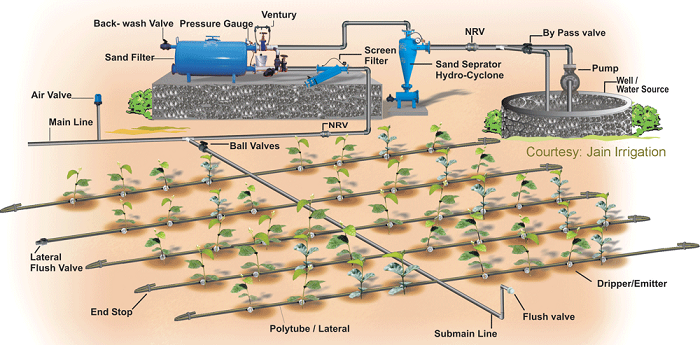Water makes life possible. Even when we use our telescopes to explore the vastness of the universe, one of the first things we look for is water. This precious liquid is key to our survival as it is largely involved in all food production.
Drip irrigation systems represent modern concepts of making good use of the water we have. They are highly effective and they can provide excellent results with very limited supplies of water. A drip irrigation system can make arid and sandy soils suitable for food propagation, which suggests that these systems may hold a possible solution to world hunger.
How do They Work?
Drip irrigation systems are quite simple. The main components are pumps, tubes and emitters. Pumps supply the water pressure, the tubes distribute the water across the field and the emitters or drippers deploy the water to the right location. Other components like valves, connectors and filters are also used to aid the process.
Over or Under
Drip irrigation systems can be placed over the ground or in the soil. The main idea is to get the water as close to the roots as possible, so underground systems may lead through the crop roots.
Conquering Uneven Terrain
Uneven terrain possesses no problem for the drip irrigation systems. Since the water is delivered straight into the soil, there is a low risk of uneven terrain affecting the water distribution. There are some limitations, but compared to sprinkling, this method of delivery is a lot more accurate. With these systems, farmers instantly gain more surface for food propagation and they save money that would previously be used to flatten and clear the area.
Fertigation is the Way to Go
Efficient crop growing entails the use of fertilizers as well. The method of adding fertilizer in the irrigation system is called fertigation. Drip irrigation systems are an excellent option for fertigation as the flow control allows farmers to carefully dose the amount of fertilizer they use.
Increasing Yields
Achieving perfect growth rate is another way to combat famine. The drip irrigation systems can provide the right combination of fertilizer and water to maximize growth. If soil is also a scarce resource, making the most of what you have can make a huge difference.
Discourages Weeds and Disease
Applying water directly where it is needed prevents the appearance of weeds on your fields. Weeds make the land less fertile and stem the development of your crops. Dripping water near the roots also keeps the humidity levels in check. Avoiding high humidity protects the crops from mould and other diseases.
Slowing Down Salinisation
The drip irrigation system also decreases the rate of salinisation. Salinisation is saturation of the ground with salts that occurs when a field is being watered. The water-soluble salts accumulate in the soil, hinder the development of all plants and make the field unusable after a while. Drip irrigation and other techniques that use less water in food production, allow farmers to work their fields longer and produce larger quantities of products before this happens.
The Prospects of Using Recycled Water
Our very existence entails the production of large amounts of waste water. Modern technology allows us to re-purpose it, rather than simply dumping it at a convenient spot. The daily production of waste water combined with a drip irrigation system, creates a small ecosystem that can be very efficient. Of course, the waste water has to be processed before reuse and there have to be strict regulation and control. Still, this is a viable solution for regions where water is not easy to come by.
Cutting Expenses to Provide Cheaper Food
Installing a drip irrigation system cuts down on labour and energy expenses. The whole system is usually centralised and it can be operated by a single worker. Dripping systems also require less pressure than sprinkling systems, which in turn significantly reduces energy costs.
Expensive Investment for Low-Value Crops
Still, the initial investment is nothing to sneeze at. If you take out water scarcity from the equation, growing low-value crops with the aid of a drip irrigation system is quite expensive. However, in regions where water and food are hard to find, it is well worth it.
Adding Tech Makes it Even More Efficient
Adding humidity sensors and connecting them to a smart watering system can further increase efficiency. Since most of the action with a drip irrigation system happens underground, these sensors can provide valuable input regarding the current situation.
Propagating this information to a central computer allows the system to regulate the drip to perfection. Building this system with decentralised pumps can also allow users to regulate irrigation locally and plant crops with different water requirements.
Success Stories
There are many success stories that show how useful a drip irrigation system can be. Africa pops up regularly, as there are many regions where drip irrigation is the only option for food propagation.
BBC News did a story on how drip irrigation and micro-dosing can be used to grow food even in the most challenging regions. Inhabitants of Niger have used this technique to convert deserts into fertile land and successfully address the hunger issue.
Non-profit organizations like Rooted in Hope show that these systems even have some unexpected benefits. Their water conservation project in Kenya, allows children to spend less time collecting water to survive and more time in the classrooms.
Conclusion
The existent drip irrigation systems have already proven that they are highly effective food production systems. They have also offered an option of dealing with population growth and inefficient use of water in some regions. As the prices of these systems drop and they become more present around the globe, we may see a day when famine will no longer be an issue.
Want more?
Want to find out in what way food impacts our quality of life? We got you covered! Find out more about food and surviving.



Leave a reply